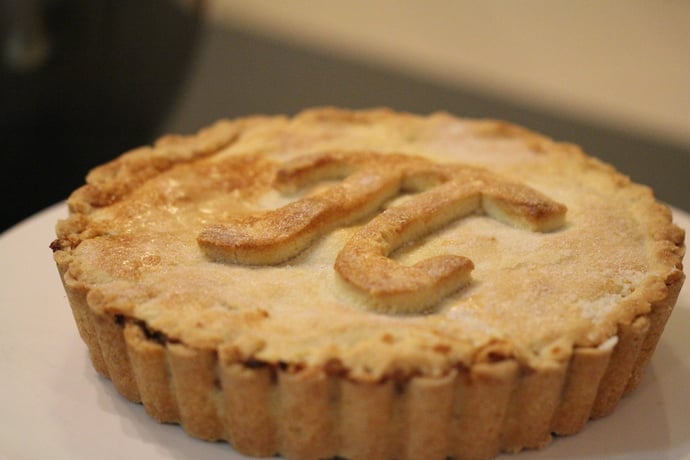What is Pi? It’s not the baked food we eat. Most people know it as March 14th, “Pi Day”, because the numeric date is 3/14 or 3.14. However, Pi is more than a day and more than three digits. It’s a number with no finite value.
Pi is the circumference or distance around a circle divided by the circle’s diameter, the longest width inside the circle. A circle with a diameter of 1, for example, has a circumference of Pi or 3.14 to an infinite number of places.
In other words, Pi is a ratio. It compares two or more numbers to indicate their value in relation to each other. As a number, Pi never ends like the ratio ¼, which is equal to exactly 0.25. Nor do the numbers repeat, like the ratio 1/6, which is equal to 0.166666 with sixes going on forever. The closest ratio for Pi is 22/7 but it’s more commonly written as 3.14 with lots of numbers after the 4.
Pi has two aspects that people find fascinating. It’s possible to calculate Pi to a million or more places to the right of the dot in 3.14. For example, the first 18 digits of Pi are 3.141592653589793238. And it’s also a useful number for quick calculations.
The first documented use of Pi happened about 4000 years ago in ancient Babylonia with a tablet that calculated Pi with a value of 3. They calculated the area of a circle by taking 3 times the square of the radius of a circle, the distance from the center of a circle to its edge or circumference. The Egyptians in the Rhind Papyrus from around 1650 BC calculated Pi to an approximate value of 3.1605.
The Greek mathematician Archimedes of Syracuse (287-212 BC) made the first calculation of Pi by measuring polygons inside and outside of a circle. The Chinese mathematician and astronomer Zu Chongzhi (429-501) used a similar approach to calculate the circumference of a circle. The use of the Greek letter for Pi started in the early 1700s with the symbol popularized by mathematician Leonhard Euler starting in 1737. All this may be interesting, but how do you use Pi?
The most common use of Pi is to calculate the circumference around a circle once you know the diameter, the longest distance across a circle. It also can be used to calculate the area inside of a circle. It also can be used to calculate the area of a circle which is equal to Pi times the radius
Squared. A circle that is 1 inch in diameter, for example, has a radius of .5 inches or half an inch. Pi multiplied by the radius .5 and then squared — multiplied by itself — gives you the area of the circle. If we take Pi as 3.14159 — the first five digits after the 3 — and multiply it by .5 we get 1.570795. The square of 1.570795 is 2.467396932025 which is the area of a circle with a 1-inch diameter.
And how many digits of Pi have been calculated? Computers have calculated the first six billion with a b digits of Pi.
Learn More
A Brief History of Pi (?)
https://www.exploratorium.edu/pi/history-of-pi
What Is Pi, and How Did It Originate?
https://www.scientificamerican.com/article/what-is-pi-and-how-did-it-originate/
Pi
https://en.wikipedia.org/wiki/Pi
Pi
https://www.mathsisfun.com/numbers/pi.html
Pi Facts
https://www.piday.org/pi-facts/
What is Pi?
https://www.britannica.com/science/pi-mathematics
Facts Behind the Mystery of Pi
https://www.rd.com/list/pi-facts/
What to Know About Pi on Pi Day
https://www.cnn.com/2023/03/14/world/pi-day-facts-history-explained-scn/index.html
Ways to Celebrate Pi Day
https://www.piday.org/ways-to-celebrate-pi-day/
Pi Day for Kids
https://www.youtube.com/watch?v=gBWb0b0RV1o
10 Ways to Celebrate Pi Day with NASA
https://science.nasa.gov/learning-resources/10-ways-to-celebrate-pi-day-with-nasa-on-march-14/
Archimede’s Constant
https://abakcus.com/directory/archimedes-constant-pi/
Archimede’s Constant
Pi for Kids
https://www.youtube.com/watch?v=lVf9jkQ2QqA
A Shortcrust History of Pie
https://www.bbc.co.uk/bitesize/articles/zmtn2sg
Why We Celebrate Pi with Pie
https://www.thepieholela.com/the-history-of-pi-day-and-why-we-celebrate-with-pie/

